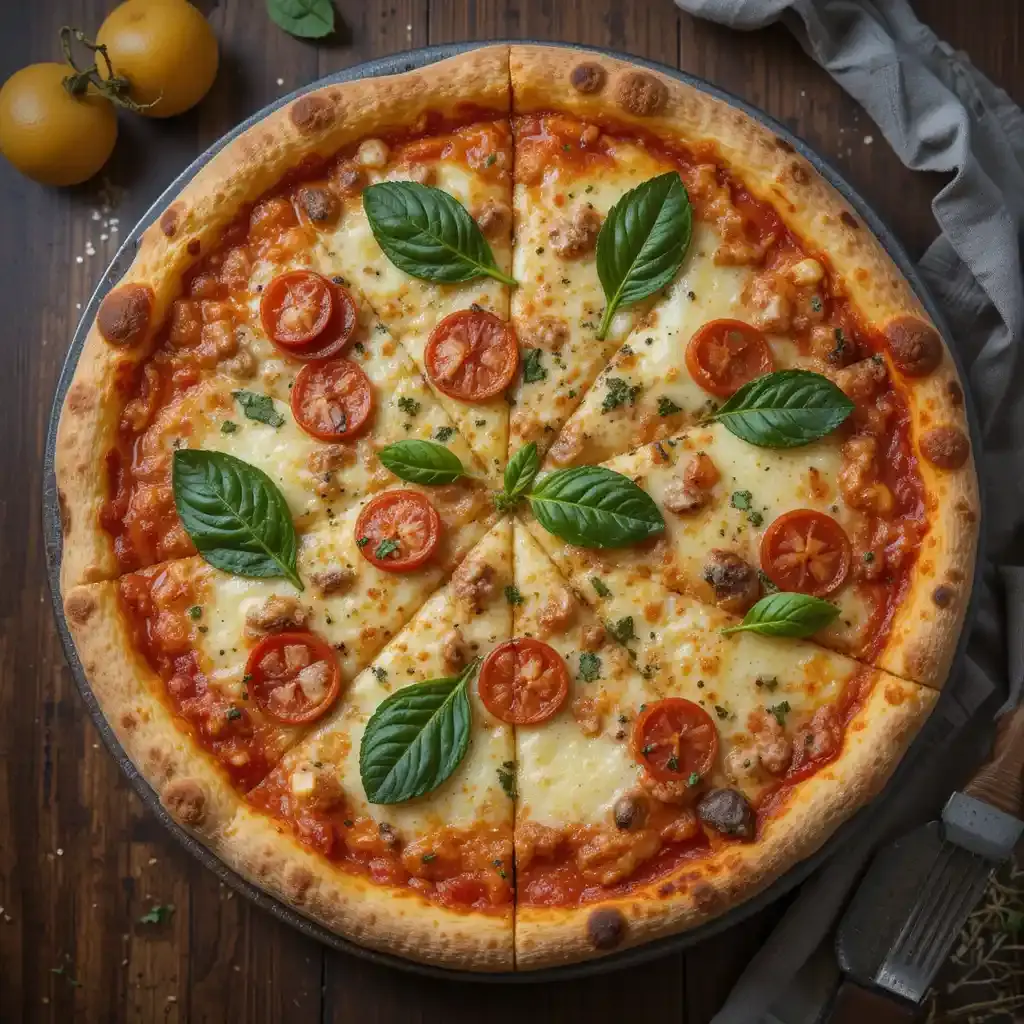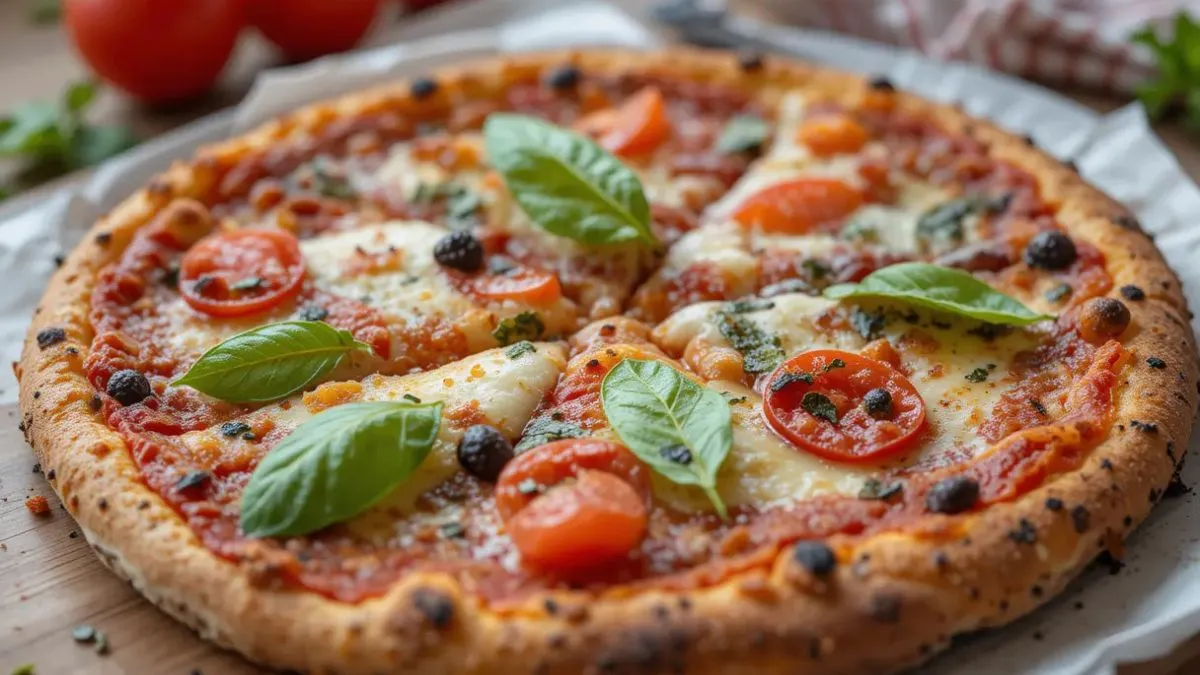Table of Contents
Pizza Rustica Recipe: A Savory Italian Meat and Cheese Pie
Explore the rich tradition of Pizza Rustica, a delicious Italian Easter pie. It brings families together for dinner. This recipe turns simple ingredients into a masterpiece that honors Italian cooking.
This pie is unlike regular pizza. It has rich meats, creamy cheeses, and a flaky crust. Each bite transports you directly to Italy.
Pizzagaina is another name for this beloved pie. It’s more than a meal; it’s a family tradition. Making this recipe connects you to Italy’s culinary past.
Key Takeaways
- Pizza Rustica is a traditional Italian Easter dish packed with flavor
- The recipe combines multiple types of cured meats and cheeses
- Perfect for family gatherings and special holiday celebrations
- Can be prepared in advance and serves multiple people
- Represents a genuine piece of Italian culinary culture
Understanding Pizza Rustica: A Traditional Italian Easter Pie
The Italian Easter pie, known as pizza rustica or pizzagaina, is a beloved tradition. It spans generations of Italian families. This savory pie is more than a recipe; it’s a cultural symbol deeply rooted in Italian culinary heritage.
Origins and Cultural Significance
Pizza rustica emerged in Southern Italian cuisine, especially in Campania and Sicily. It was tied to Easter celebrations. Families made this hearty pie to end the Lenten fasting period.
- Traditionally prepared by grandmothers and mothers
- Symbolizes family unity and celebration
- Represents abundance after a period of restraint
Regional Variations Across Italy
Different regions in Italy have their own pizza rustica recipes. Each adds its local touch, showing the country’s rich culinary diversity.
| Region | Unique Characteristic |
| Naples | Adds ricotta cheese to the filling |
| Sicily | Includes more diverse meat selections |
| Calabria | Uses spicier seasonings |
Why It’s Called Pizzagaina
The term pizzagaina comes from the pie’s regional roots. In Southern Italy, it’s a phonetic adaptation of “pizza chiena,” meaning “full pizza” or “stuffed pizza”.
“A slice of pizzagaina is like a window into Italian family traditions”
Understanding pizza rustica’s rich background shows it’s more than a simple recipe. It’s a culinary narrative connecting generations of Italian families.
Essential Ingredients for an Authentic Pizza Rustica
To make a tasty pizza rustica, you need the right ingredients. These should be high-quality to capture the true taste of this Italian Easter pie. Choosing the best ingredients is key to getting the rich flavors and textures this dish is known for.
The main ingredients for a real pizza rustica include:
- Cheeses: Ricotta, mozzarella, and pecorino romano make up the creamy base
- Cured Meats: Prosciutto, salami, and sopressata add strong flavors
- Fresh Ingredients: Eggs, herbs, and black pepper
- Pastry Components: Flour, butter, and eggs for the crust
For a true Italian Easter pie, choose high-quality ingredients. Your local Italian deli or specialty store can help. They offer premium meats and cheeses that make your pizza rustica stand out.
| Ingredient Category | Recommended Choices | Quality Indicators |
| Cheeses | Ricotta, mozzarella, pecorino | Creamy, fresh, imported if possible |
| Meats | Prosciutto di Parma, genoa salami | Artisanal, thinly sliced |
| Herbs/Spices | Fresh basil, black pepper | Freshly ground, vibrant aroma |
A true pizza rustica recipe is about honoring tradition through carefully selected ingredients that tell a story of Italian culinary heritage.
By picking top-notch ingredients, you’ll turn your pizza rustica into a real Italian culinary experience. It will celebrate the rich flavors of Easter traditions.
Making the Perfect Pizza Rustica Crust from Scratch
Creating an authentic pizza rustica recipe starts with mastering the perfect crust. The foundation of this Italian Easter bread demands precision and care. Your crust will make or break the entire dish, so pay close attention to each step of preparation.
Dough Preparation Essentials
Successful pizza rustica begins with high-quality ingredients and careful mixing. Choose the right flour – a mix of all-purpose and pastry flour is best for that flaky texture.
- Use cold butter cut into small cubes
- Keep ingredients refrigerated before mixing
- Handle dough minimally to prevent tough crust
Rolling and Shaping Techniques
Precision matters when rolling out your pizza rustica dough. Work on a cool, lightly floured surface to prevent sticking and maintain the delicate texture.
| Technique | Key Tip |
| Rolling | Use gentle, even pressure from center outward |
| Thickness | Aim for 1/8 inch consistent thickness |
| Transferring | Use rolling pin to lift dough carefully |
Pre-baking Guidelines
Pre-baking your crust ensures a crisp bottom and prevents soggy results. Blind bake the crust for 10-12 minutes at 375°F before adding your filling.
“The secret to a perfect pizza rustica is in the crust’s preparation and baking technique.”
Remember that practice makes perfect when creating your pizza rustica recipe. Each attempt will improve your technique and bring you closer to an authentic Italian Easter bread experience.
Selecting and Preparing the Meat Filling
Starting a pizza rustica recipe means picking top-notch cured meats. Traditional pizzagaina uses a mix of Italian meats. These add depth and richness to the dish.
For your pizza rustica, consider these classic meats:
- Prosciutto di Parma
- Genoa salami
- Capicola
- Pancetta
The secret to a great meat filling is mixing flavors and textures well. Cut the meats into small, even pieces. This ensures they spread out evenly in the pie.
| Meat Type | Flavor Profile | Recommended Quantity |
| Prosciutto | Salty, delicate | 1/2 cup, thinly sliced |
| Salami | Spicy, robust | 1/3 cup, diced |
| Capicola | Slightly spicy | 1/4 cup, chopped |
Pro tip for your pizza rustica recipe: Let the meats warm up to room temperature before chopping. This prevents tearing and ensures clean cuts. Mix the diced meats with ricotta and eggs. This creates a smooth filling that makes your pizzagaina authentic.
“The art of pizza rustica lies in the careful selection and preparation of its meats.”
Don’t forget to trim off too much fat from the meats. But keep enough to keep the flavor rich. This is what makes this Italian Easter pie so special.
The Complete Pizza Rustica Recipe
Making an authentic Italian Easter pie is a labor of love. This recipe will help you create a delicious traditional dish. It brings the flavors of Italy right to your kitchen.
Preparation Time and Yield
Your pizza rustica will take about 2 hours to make. It serves 8-10 people. Here’s a breakdown of the time needed:
- Servings: 8-10 people
- Preparation time: 60 minutes
- Baking time: 45-50 minutes
- Total time: Approximately 2 hours
Step-by-Step Instructions
Here’s how to make your perfect Italian Easter pie:
- Prepare the crust ingredients and mix thoroughly
- Create the meat and cheese filling
- Roll out the bottom crust in a deep pie dish
- Layer meats and cheeses carefully
- Cover with top crust and seal edges
- Create ventilation slits on top
Temperature and Timing Guide
| Stage | Temperature | Duration |
| Preheating | 425°F | 15 minutes |
| Initial Baking | 425°F | 20 minutes |
| Finishing Bake | 375°F | 25-30 minutes |
| Cooling | Room Temperature | 30 minutes |
Pro tip: Let your pizza rustica rest for 30 minutes after baking. This allows flavors to settle and makes slicing easier.
Cheese Selection and Combinations
Making the perfect pizza rustica recipe starts with the right cheese mix. The Italian Easter pie needs a balance of flavors to make it special.
Traditional cheeses for pizza rustica include:
- Ricotta – provides a creamy, smooth base
- Pecorino Romano – adds sharp, salty notes
- Parmigiano-Reggiano – brings depth and complexity
- Fresh mozzarella – creates a luxurious texture
When picking cheeses for your Italian Easter pie, keep these tips in mind:
| Cheese Type | Flavor Intensity | Recommended Quantity |
| Ricotta | Mild | 2 cups |
| Pecorino Romano | Sharp | 1/2 cup |
| Parmigiano-Reggiano | Intense | 1/4 cup |
| Mozzarella | Creamy | 1 cup |
Pro tip: Always grate hard cheeses fresh and mix them well with ricotta. This makes a smooth filling for your pizza rustica. Try different mixes to find your favorite.
“The key to an outstanding Italian Easter pie is the perfect balance of cheeses.”
Remember, the quality of your cheese is key. Choose fresh, high-quality ingredients. This will make your pizza rustica a true Italian culinary masterpiece.

Tips for Achieving the Perfect Texture and Flavor
Making a great pizza rustica recipe is more than just following a list of ingredients. It’s about mastering the details of how you prepare it. This can take your pizzagaina from good to amazing. Let’s look at some expert tips to make sure your pie is delicious every time.
Common Mistakes to Avoid
When making pizza rustica, there are a few big mistakes to watch out for:
- Overmixing the dough, which makes it tough
- Using cold ingredients that don’t mix well
- Not pre-baking the crust for a crispy bottom
- Putting too many ingredients in the filling
Techniques for Perfect Texture
Achieving the perfect texture in your pizzagaina requires precision and attention to detail. Here are some strategies:
- Ensure all ingredients are at room temperature before mixing.
- Be gentle when mixing the dough
- Begin by allowing the dough to rest for at least 30 minutes. This step is essential before rolling it out.
- Brush the top with egg wash for a golden color
Storage and Reheating Best Practices
| Storage Method | Duration | Recommended Technique |
| Refrigerator | 3-4 days | Cover with aluminum foil |
| Freezer | Up to 1 month | Wrap tightly in plastic wrap |
| Reheating | 20-25 minutes | Oven at 350°F, cover with foil |
By following these tips, you’ll make a pizza rustica recipe that’s just like the real thing. Remember, the more you practice, the better you’ll get!
“Cooking is an art, while baking is a science.”
Serving Suggestions and Accompaniments
Your Italian Easter pie is a feast for the eyes and taste buds. The pizza rustica recipe offers many ways to serve it. This can turn a simple meal into a memorable one.
Here are some classic sides to go with your pizza rustica:
- Fresh green salad with vinaigrette
- Roasted seasonal vegetables
- Crusty Italian bread
- Pickled vegetable antipasti
Wine pairings can make your pizza rustica even better. Opt for bold red wines that complement the pie’s meat and cheese.
| Wine Type | Flavor Profile | Recommended Pairing |
| Chianti | Medium-bodied, tannic | Excellent match for savory pie |
| Sangiovese | Bright acidity, red fruit notes | Cuts through rich cheese |
| Barbera | Low tannins, high acidity | Complements meat filling |
Temperature is key when serving your Italian Easter pie. Let it rest for 15-20 minutes after baking. This helps its structure and flavor.
“The presentation of a dish is half the joy of eating.”
For a fresh presentation, start by slicing your Pizza Rustica into smaller portions. This simple step will instantly enhance its appearance. Serve them as appetizers or at brunch. Incorporate fresh herbs such as basil or parsley to add a vibrant touch of color.
Make-Ahead and Storage Guidelines
Preparing your Italian Easter pie ahead of time can save you a lot of stress. The pizza rustica recipe is great for planning ahead. This way, you can enjoy a delicious meal with your family without last-minute worries.
Freezing Your Pizza Rustica
Freezing your Italian Easter pie is a smart move to keep its taste and texture. Here’s how to do it right:
- Cool the pizza rustica completely before freezing
- Wrap the pie snugly in two layers of plastic wrap to ensure it is secure.
- Add a layer of aluminum foil for extra protection.
- Label with the date and contents
- Freeze it for up to 3 months.
Proper Reheating Techniques
To bring your frozen pizza rustica back to life, follow these steps:
- Thaw the pie in the refrigerator overnight
- Preheat your oven to 350°F (175°C)
- Remove plastic wrap and foil
- Place the pie on a baking sheet
- Heat for 20-25 minutes until warm throughout
Pro tip: Cover the edges with aluminum foil if they start to brown too quickly. This keeps your pizza rustica moist and flavorful, just like when it was first baked.
“A well-preserved pizza rustica is a testament to the timeless tradition of Italian Easter cooking.”
By using these storage and reheating tips, you can enjoy your homemade pizza rustica recipe. It will taste just as good, whether it’s fresh or reheated days later.
Variations and Modern Adaptations
Your traditional pizza rustica recipe doesn’t have to stay the same. Modern cooks are adding new twists to this classic Italian Easter pie. They keep its rich heritage but bring in fresh flavors.
Vegetarian versions of pizzagaina are gaining fans who want meat-free options. You can change the classic recipe by using new ingredients:
- Roasted vegetable medleys
- Exotic mushroom combinations
- Artichoke and spinach blends
- Grilled zucchini and eggplant
Cheese enthusiasts can try unique mixes to enhance the pizza rustica. Look into different cheeses that add richness and complexity:
| Cheese Type | Flavor Profile | Recommended Pairing |
| Pecorino Romano | Sharp and salty | Roasted vegetables |
| Ricotta Salata | Mild and creamy | Fresh herbs |
| Smoked Provolone | Intense and rich | Cured meats |
Global trends have led chefs to mix pizza rustica with international flavors. You can add global ingredients while keeping the dish’s essence. Try Mediterranean, Latin American, or Asian-fusion twists.
“Cooking is about passion, creativity, and respecting traditional recipes while daring to innovate.”
When you update your pizzagaina, mix new ideas with tradition. Aim to honor its Italian origins while pleasing today’s tastes.
Conclusion
Learning to make pizza rustica is more than just cooking. It’s about connecting with a long-standing culinary tradition. This Italian Easter pie is a delicious trip through Italian family cooking, offering flavors loved for centuries.
Your kitchen can be a doorway to real Italian food with pizza rustica. This guide gives you the recipe and techniques to make a dish that shows off Italian cooking’s heart. Whether for a holiday or a weekend, pizza rustica makes a meal to remember.
Cooking is an art that needs passion and practice. Every time you make this pie, you get better and appreciate traditional recipes more. Don’t worry about the steps – enjoy learning and making a meal that links you to a rich culinary culture.
Understanding pizza rustica’s ingredients, techniques, and cultural importance means more than just baking. It’s about keeping a piece of Italian culinary history alive. Begin your cooking journey and let the smells of fresh ingredients warm your kitchen with tradition.
FAQ
What exactly is Pizza Rustica?
Pizza Rustica is a traditional Italian savory pie. It’s often served during Easter. It has a flaky pastry crust filled with cured meats, cheeses, and eggs.
It’s also known as Pizzagaina in some Italian-American communities. This dish is a beloved holiday tradition from Southern Italy.
Is Pizza Rustica the same as a regular pizza?
No, Pizza Rustica is quite different from a traditional pizza. It’s more like a hearty pie or quiche. It has a pastry crust and a dense filling of ricotta, mozzarella, and cured meats.
It’s typically served at room temperature. This makes it a special Easter tradition in Italian cuisine.
Can I make Pizza Rustica vegetarian?
Yes, a vegetarian version of Pizza Rustica can be made. Swap the cured meats for roasted vegetables such as zucchini, eggplant, or bell peppers.
Keep the creamy combination of ricotta intact, mozzarella, and Parmigiano-Reggiano cheeses. This will keep the traditional flavor profile.
How long can I store Pizza Rustica?
You can store Pizza Rustica in an airtight container in the refrigerator for up to 4-5 days. It can also be stored in the freezer for 2–3 months.
When reheating, let it come to room temperature slowly. This helps preserve its texture and flavor.
What are the best cheeses to use in Pizza Rustica?
Traditional Pizza Rustica uses ricotta, mozzarella, and Parmigiano-Reggiano. These cheeses give a creamy texture, rich flavor, and a distinctive Italian taste.
Using high-quality, fresh cheeses is key to creating an authentic dish.
Is Pizza Rustica only eaten at Easter?
While Pizza Rustica is most closely associated with Easter, it can be enjoyed year-round. Many families now prepare it for special occasions, brunches, or as a hearty main course at gatherings.
What’s the difference between Pizza Rustica and Quiche?
Both are savory pies with eggs and cheese, but Pizza Rustica is distinctly Italian. It has more meat and a denser filling than French quiche.
The crust is also different. Pizza Rustica has a flakier, more pastry-like crust than a traditional quiche.
Can I make the crust from scratch or should I use store-bought?
Making the crust from scratch allows you to control the ingredients. This gives you a more authentic texture. A traditional Pizza Rustica crust is made with flour, butter, eggs, and sometimes wine.
This creates a rich, flaky pastry that complements the filling perfectly.

